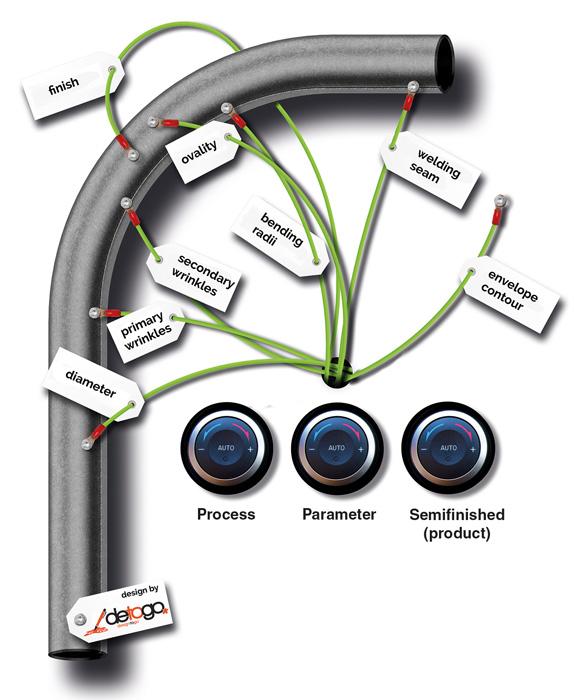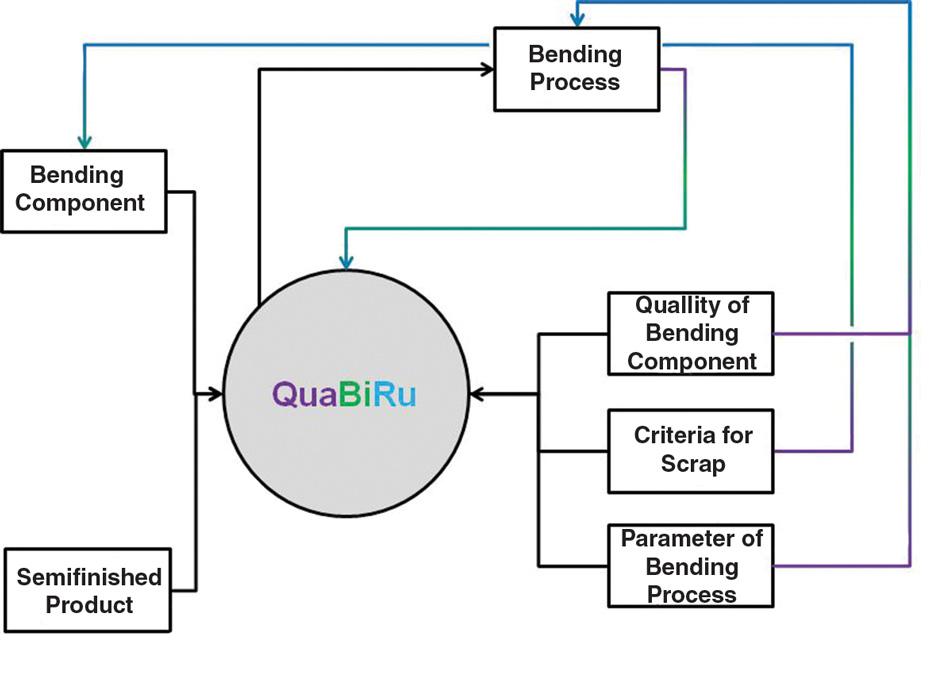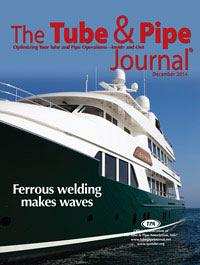- FMA
- The Fabricator
- FABTECH
- Canadian Metalworking
Categories
- Additive Manufacturing
- Aluminum Welding
- Arc Welding
- Assembly and Joining
- Automation and Robotics
- Bending and Forming
- Consumables
- Cutting and Weld Prep
- Electric Vehicles
- En Español
- Finishing
- Hydroforming
- Laser Cutting
- Laser Welding
- Machining
- Manufacturing Software
- Materials Handling
- Metals/Materials
- Oxyfuel Cutting
- Plasma Cutting
- Power Tools
- Punching and Other Holemaking
- Roll Forming
- Safety
- Sawing
- Shearing
- Shop Management
- Testing and Measuring
- Tube and Pipe Fabrication
- Tube and Pipe Production
- Waterjet Cutting
Industry Directory
Webcasts
Podcasts
FAB 40
Advertise
Subscribe
Account Login
Search
Developing a national, international bending standard for tube and pipe
- By Eric Lundin
- January 23, 2015
- Article
- Tube and Pipe Fabrication

Figure 1
The principle of QuaBiRu is to develop a new manufacturing standard to minimize production costs and scrap.
Illustration designed by Sascha Weinrich and Kai Haase GbR, Design to Go, www.detogo.de.
Despite decades of development, the processes used for bending pipe, tubes, and profiles are still under continuous improvement.1 This is a result of the varied uses of bent components. The construction, furniture, and transportation sectors including automotive, aerospace, and rail are among the many that drive increasingly stringent standards for mechanical applications. Meanwhile, industries such as food and beverage; pharmaceutical; chemical processing; and oil and gas extraction, processing, and transportation drive the standards for piping systems.
Regardless of the application, bent components must comply with industry-specific tolerances. The demand for quality increases by an order of magnitude if the tube is to be used in measurement equipment, such as a unit that measures fluid flow influenced by the Coriolis force. These requirements merge into strict compliance of the envelope contour and, in many cases, do not allow any deformation or wall thickness changes.
In many cases, the specification is so strict that one bending process or another simply cannot form the component. In some cases, the OEM lacks an understanding of the origins of these special bend quality characteristics. Furthermore, the machine operators often do not know how to change the process parameters to achieve the specified quality characteristic.
Project Goals
A research project on this topic, titled “Return on Technology Quality Standard for Tube and Pipe Bending Technology” (QuaBiRu), was developed to establish a quality and measurement standard for bent pipe, tube, and profile components. The project is conducted under the direction of the chair of forming technology of the University of Siegen and the chair of production engineering and forming technology of the University of Applied Science in Iserlohn/Meschede (see Figure 1). Machine manufacturer Tracto-Technik GmbH & Co. KG acts as a strategic partner to the interface in the bending industry and provides software know-how.
The project partners will solicit feedback from the bending industry and related sectors by holding workshops organized by the institutes, such as “Biegen in Siegen—Expertenworkshop.” Held at the University of Siegen, the research will examine all of the influences that enable or prevent a process from achieving the dimensions and tolerances of a good part. Updates on the research will be published periodically in trade journals and scientific conferences. The aim is to establish a German, European, or international standard. This standard will be a further contribution to a value-driven innovation strategy based on standardization.
Return the Quality to the Manufacturing Process
The first step is to list all of the quality characteristics based on VDI-3431,2 which will require extensive research on bent components and interviews with bending machine operators. The second step is to prioritize them by relevance, and the third is to categorize the influences that the processes have on the quality characteristics of the bent component. These influences will be researched and listed according to their impact on the bent component. The result will be a matrix with the three input parameters: quality characteristic of the bent component, technical function, and the bending process and its parameters (see Figure 2). This matrix, in turn, will result in an intelligent database, one that allows project engineers to specify components by considering the part’s design and its technical function when it is put into use.
Research Results and Commercialization
The goal is to develop a commercially available software program that helps project engineers get more products to market in less time and at less cost than before. It helps the fabricator involved in the bending by identifying the optimal bending process upfront, eliminating trial-and-error processes. It also helps to conserve the programmer’s time, enabling him to focus on optimizing the software. All relevant information and results of the research project are to be combined into one software package, allowing the user to manage all of the inputs, outputs, and related parameters in a short timeframe while adhering to the relevant quality characteristics.
Financial Support
Financial support for the University of Siegen and for the University of Applied Science in Meschede is provided by the German Federal Ministry of Economic Affairs and Energy, based on a decision of the German Federal Parliament.
Notes
1. B. Engel, et al, “Die Auslegung von Rohren und Profilen einfach gestalten,” Maschinenmarkt (10), Vogel Verlag, 2012, S. 26-27.

Figure 2
A diagram of the QuaBiRu functions shows the parameters for adjusting a bending process. The concept also is intended to minimize setup time.
2. VDI 3431-draft, “Inspection notes for profile bending elements,” Beuth Verlag, Berlin, 2014.
Univ.-Prof. Dr.-Ing. Bernd Engel is professor of the chair of forming technology and Dipl.-Wirt.-Ing. Christopher Kuhnhen is research fellow of bending technology at Lehrstuhl für Umformtechnik (UTS), Universität Siegen, Paul-Bonatz-Strasse 9-11, 57076 Siegen, Germany 49-271-740-4404.
Prof. Dr.-Ing. Matthias Hermes is professor of the chair of production technology/forming technology at the University of Applied Science, Fachhochschule Südwestfalen, Jahnstrasse 23, 59872 Meschede, Germany, 49-291-9910-690.
About the Author

Eric Lundin
2135 Point Blvd
Elgin, IL 60123
815-227-8262
Eric Lundin worked on The Tube & Pipe Journal from 2000 to 2022.
About the Publication
subscribe now

The Tube and Pipe Journal became the first magazine dedicated to serving the metal tube and pipe industry in 1990. Today, it remains the only North American publication devoted to this industry, and it has become the most trusted source of information for tube and pipe professionals.
start your free subscription- Stay connected from anywhere

Easily access valuable industry resources now with full access to the digital edition of The Fabricator.

Easily access valuable industry resources now with full access to the digital edition of The Welder.

Easily access valuable industry resources now with full access to the digital edition of The Tube and Pipe Journal.
- Podcasting
- Podcast:
- The Fabricator Podcast
- Published:
- 04/16/2024
- Running Time:
- 63:29
In this episode of The Fabricator Podcast, Caleb Chamberlain, co-founder and CEO of OSH Cut, discusses his company’s...
- Trending Articles
Zekelman Industries to invest $120 million in Arkansas expansion

3D laser tube cutting system available in 3, 4, or 5 kW

Corrosion-inhibiting coating can be peeled off after use

Brushless copper tubing cutter adjusts to ODs up to 2-1/8 in.

HGG Profiling Equipment names area sales manager

- Industry Events
16th Annual Safety Conference
- April 30 - May 1, 2024
- Elgin,
Pipe and Tube Conference
- May 21 - 22, 2024
- Omaha, NE
World-Class Roll Forming Workshop
- June 5 - 6, 2024
- Louisville, KY
Advanced Laser Application Workshop
- June 25 - 27, 2024
- Novi, MI


























